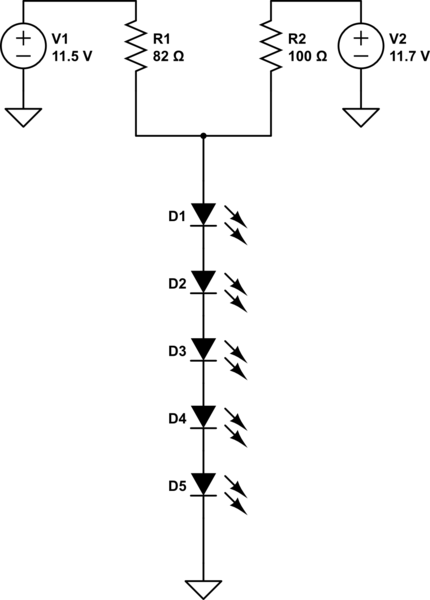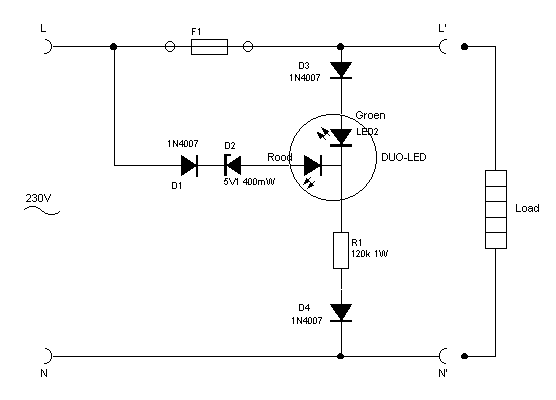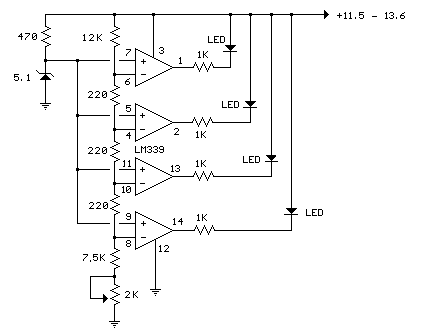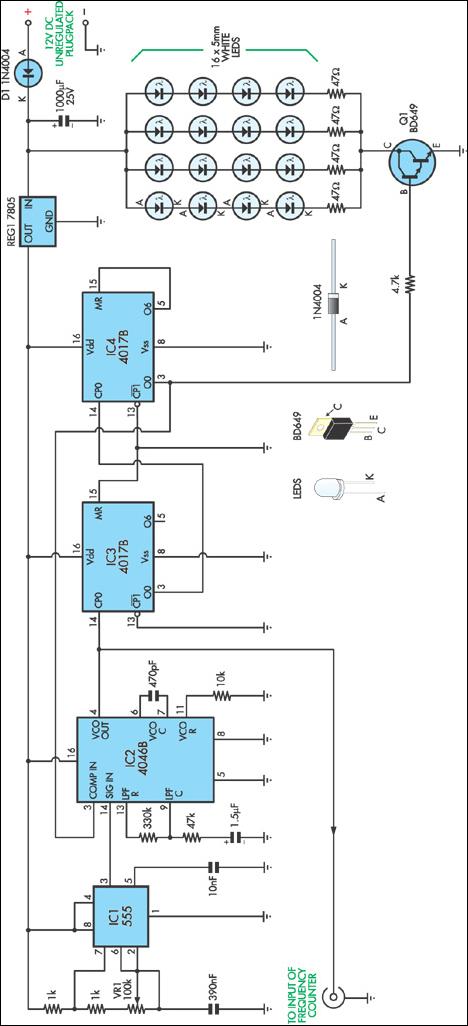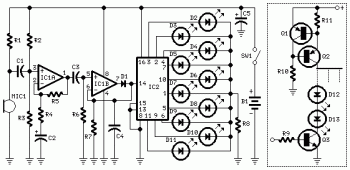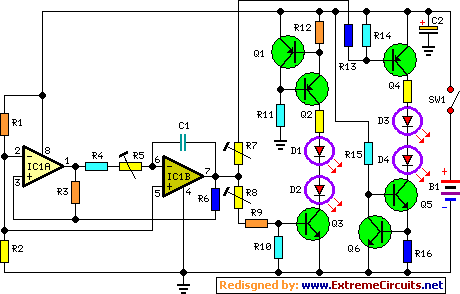
Dicing With LEDs
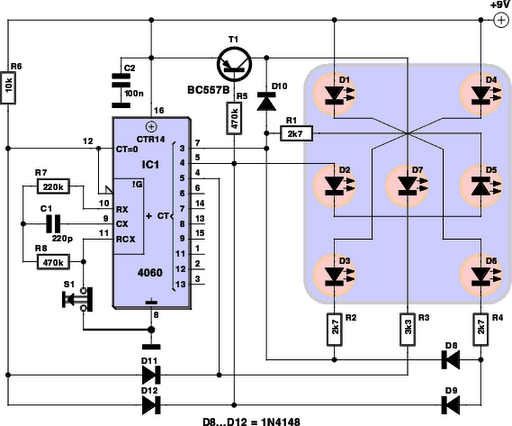
Every DIY enthusiast creates their own electronic dice using LEDs as indicators. This eliminates the need to physically roll dice; instead, a button is pressed. The circuit is designed to prevent any manipulation of the outcome, ensuring fairness. This project demonstrates that an electronic die can be constructed with standard components in a compact form. The primary component is a 4060 digital counter (IC1), which includes an integrated oscillator. Only two resistors (R7 and R8) and one capacitor (C7) are required to generate the clock signal. The clock signal is divided internally by various factors within the IC. For example, the output on pin 7 (CT3) produces a square wave with a frequency that is the clock frequency divided by 8. Other outputs, such as CT4 and CT5, divide the clock signal by 16 and 32, respectively. This division results in a binary count which simulates the counting mechanism of a die. Since a die has six possible outcomes, three bits (the first three outputs) of the counter are necessary to drive the display. To limit the counter to six states, components D11, D12, and R6 reset the counter to its initial state upon reaching the seventh state (binary 110). When this occurs, pins 4 and 5 of the IC output a high signal, triggering the reset through R6. The display is composed of seven LEDs arranged to mimic the traditional markings on a die. It is important to note that except for the "1" state, two LEDs will illuminate simultaneously, allowing for only four distinct indications instead of seven. This design choice also reduces current consumption by wiring pairs of LEDs in series. Resistors R1 to R4 limit the LED current to approximately 2 mA, which is sufficient for low-current, bright LEDs. Resistor R3 has a higher resistance since it drives only one LED. The circuit is designed for a 9-V battery, with current consumption varying between 2.5 mA and 6.5 mA depending on the number of lit LEDs. The LEDs remain adequately bright even at a supply voltage of 6 V, contingent on the characteristics of the LEDs used. Diodes D8 to D10 and transistor T1 are included to represent all possible states of a die, particularly those with two or three spots arranged diagonally. For those interested in the design specifics, a table outlines the six binary states, the corresponding lit LEDs, and the displayed number of spots. The die is activated by switch S1, which is normally closed, stopping the oscillator by grounding its input. Pressing S1 activates the oscillator, causing the LED states to change at a rate of 1 kHz, too rapid for the human eye to discern. This high frequency ensures randomness in the die's outcome when S1 is released. The circuit can be constructed on a small perforated prototyping board, ensuring the LEDs are arranged according to the schematic to maintain accurate spot patterns. Once assembled, the circuit board should be housed in a plastic enclosure along with a 9-V battery for power.
The electronic dice circuit utilizes a 4060 digital counter as its core component, integrating both the counting and oscillation functions. The oscillator is configured using resistors R7 and R8 and capacitor C7, generating a stable clock signal necessary for the counter's operation. The output from the counter is carefully managed to ensure that only six states are represented, aligning with the traditional six faces of a die. The reset mechanism, facilitated by diodes D11 and D12, along with resistor R6, ensures that the counter does not exceed the desired six states, maintaining the integrity of the dice function.
The LED display is designed to reflect the traditional layout of a die, with careful consideration of the LED connections to ensure that two LEDs illuminate simultaneously for all states except for the "1." This design not only simplifies the circuit but also optimizes power consumption, making it suitable for battery operation. The use of low-current LEDs ensures that the circuit remains energy-efficient while still providing adequate brightness for visibility.
The inclusion of diodes D8 to D10 and transistor T1 is critical for accurately displaying the two and three-spot configurations, which require diagonal arrangements. This attention to detail enhances the realism of the electronic die, making it a more engaging and functional device for users. The activation switch S1 serves a dual purpose: it initiates the counting process while also ensuring that the circuit remains dormant when not in use, thus preserving battery life.
Overall, this electronic dice circuit exemplifies a well-thought-out design that combines functionality with efficiency, making it an excellent project for DIY electronics enthusiasts. The straightforward assembly process, along with the compact design, allows for easy integration into various applications, providing a reliable and entertaining alternative to traditional dice.Every self-respecting DIYer makes his own electronic dice with LEDs as spots. Then you don`t have to throw the dice anymore just push the button. The electronics also ensures that nobody can try to improve his luck by fiddling with the dice. Too bad for sore losers! This circuit proves that an electronic die built using standard components can be made quite compact. The key component of here is a type 4060 digital counter (IC1). This IC has an integrated oscillator stage, so only two resistors (R7 and R8) and a capacitor (C7) are necessary to generate the clock signal. The clock signal is divided by various factors by the internal digital circuitry of the IC. The division factors are designated by CT` in the IC drawing symbol. For instance, the signal on the CT3 output (pin 7) is a square wave with a frequency equal to the clock frequency divided by 23 (8).
The clock signal is divided by 24 (16) on the CT4 output, by 25 (32) on the CT5 output, and so on. This means the output signals form a binary number that Dicing with LEDs counts upwards, which is naturally what a counter does. Of course, a die has only six possible values marked on the six sides of a cube. This means that at least three bits (the first three outputs) of the counter are necessary to drive a display.
Eight different counter states (23) can be represented with three bits, but in this case the counter must be restricted to six states. To make sure this happens, D11, D12 and R6 are used to reset the counter to its initial state when it reaches the seventh state, which means when it reaches a binary count of 110.
When this happens, pins 4 and 5 of the IC are both logic 1` (high level), which causes a logic 1` to be applied to pin 12 via resistor R6. This causes the counter to be reset, which is what we want. The display consists of seven LEDs arranged in the same pattern as the usual markings on a normal die.
This arrangement is shown in the schematic diagram. Before you begin thinking about the proper logical connections between the LEDs and the counter outputs, you can start by noting that except for the 1` state there will always be two LEDs lit up at the same time. This means that only four distinct indications are necessary, instead of seven (with a total of seven LEDs).
Another advantage of this is that the current consumption can be reduced by connecting pairs of LEDs in series. Resistors R1 R4 limit the current through the LEDs to approximately 2 mA. This means you have to use low-current LEDs. They are nice and bright at a current of 2 mA. Resistor R3 has a higher value because only one LED is driven via it. For convenience, the circuit is dimensioned based on using a 9-V battery. The current consumption of the circuit depends on the number of LEDs that are illuminated, and with our prototype it varied over a range of approximately 2.
5 mA to 6. 5 mA. The LEDs still produce enough light even when the supply voltage is as low as 6 V, but this depends strongly on the characteristics of the low-current LEDs used in the circuit. Diodes D8 D10 and transistor T1 are necessary to enable all the states of a normal die to be shown. By that, we primarily mean the states with two or three spots, which must be located diagonally. For readers who want to delve more deeply into the design, the following table shows the six different binary states, which LEDs are lit up for each state, and the number of spots shown by the die.
The die is operated by switch S1. In the quiescent state, the break contact of S1 is closed and the oscillator is stopped because the input of the oscillator stage is connected to ground via the switch. When S1 is pressed, the oscillator starts running and causes the states of the LEDs to change at a rate of 1 kHz, which is too fast to follow with the naked eye.
This high frequency ensures that the state of the die is purely random when S1 is released, so there is no regularity or pattern in the results. The circuit can be assembled on a small piece of perforated prototyping board. Fit the LEDs in exactly the same pattern as shown in the schematic diagram, since otherwise the spot patterns will not correspond to a real die.
When you have assembled the circuit board, fit it in a plastic enclosure along with a 9-V battery to provide power. 🔗 External reference
The electronic dice circuit utilizes a 4060 digital counter as its core component, integrating both the counting and oscillation functions. The oscillator is configured using resistors R7 and R8 and capacitor C7, generating a stable clock signal necessary for the counter's operation. The output from the counter is carefully managed to ensure that only six states are represented, aligning with the traditional six faces of a die. The reset mechanism, facilitated by diodes D11 and D12, along with resistor R6, ensures that the counter does not exceed the desired six states, maintaining the integrity of the dice function.
The LED display is designed to reflect the traditional layout of a die, with careful consideration of the LED connections to ensure that two LEDs illuminate simultaneously for all states except for the "1." This design not only simplifies the circuit but also optimizes power consumption, making it suitable for battery operation. The use of low-current LEDs ensures that the circuit remains energy-efficient while still providing adequate brightness for visibility.
The inclusion of diodes D8 to D10 and transistor T1 is critical for accurately displaying the two and three-spot configurations, which require diagonal arrangements. This attention to detail enhances the realism of the electronic die, making it a more engaging and functional device for users. The activation switch S1 serves a dual purpose: it initiates the counting process while also ensuring that the circuit remains dormant when not in use, thus preserving battery life.
Overall, this electronic dice circuit exemplifies a well-thought-out design that combines functionality with efficiency, making it an excellent project for DIY electronics enthusiasts. The straightforward assembly process, along with the compact design, allows for easy integration into various applications, providing a reliable and entertaining alternative to traditional dice.Every self-respecting DIYer makes his own electronic dice with LEDs as spots. Then you don`t have to throw the dice anymore just push the button. The electronics also ensures that nobody can try to improve his luck by fiddling with the dice. Too bad for sore losers! This circuit proves that an electronic die built using standard components can be made quite compact. The key component of here is a type 4060 digital counter (IC1). This IC has an integrated oscillator stage, so only two resistors (R7 and R8) and a capacitor (C7) are necessary to generate the clock signal. The clock signal is divided by various factors by the internal digital circuitry of the IC. The division factors are designated by CT` in the IC drawing symbol. For instance, the signal on the CT3 output (pin 7) is a square wave with a frequency equal to the clock frequency divided by 23 (8).
The clock signal is divided by 24 (16) on the CT4 output, by 25 (32) on the CT5 output, and so on. This means the output signals form a binary number that Dicing with LEDs counts upwards, which is naturally what a counter does. Of course, a die has only six possible values marked on the six sides of a cube. This means that at least three bits (the first three outputs) of the counter are necessary to drive a display.
Eight different counter states (23) can be represented with three bits, but in this case the counter must be restricted to six states. To make sure this happens, D11, D12 and R6 are used to reset the counter to its initial state when it reaches the seventh state, which means when it reaches a binary count of 110.
When this happens, pins 4 and 5 of the IC are both logic 1` (high level), which causes a logic 1` to be applied to pin 12 via resistor R6. This causes the counter to be reset, which is what we want. The display consists of seven LEDs arranged in the same pattern as the usual markings on a normal die.
This arrangement is shown in the schematic diagram. Before you begin thinking about the proper logical connections between the LEDs and the counter outputs, you can start by noting that except for the 1` state there will always be two LEDs lit up at the same time. This means that only four distinct indications are necessary, instead of seven (with a total of seven LEDs).
Another advantage of this is that the current consumption can be reduced by connecting pairs of LEDs in series. Resistors R1 R4 limit the current through the LEDs to approximately 2 mA. This means you have to use low-current LEDs. They are nice and bright at a current of 2 mA. Resistor R3 has a higher value because only one LED is driven via it. For convenience, the circuit is dimensioned based on using a 9-V battery. The current consumption of the circuit depends on the number of LEDs that are illuminated, and with our prototype it varied over a range of approximately 2.
5 mA to 6. 5 mA. The LEDs still produce enough light even when the supply voltage is as low as 6 V, but this depends strongly on the characteristics of the low-current LEDs used in the circuit. Diodes D8 D10 and transistor T1 are necessary to enable all the states of a normal die to be shown. By that, we primarily mean the states with two or three spots, which must be located diagonally. For readers who want to delve more deeply into the design, the following table shows the six different binary states, which LEDs are lit up for each state, and the number of spots shown by the die.
The die is operated by switch S1. In the quiescent state, the break contact of S1 is closed and the oscillator is stopped because the input of the oscillator stage is connected to ground via the switch. When S1 is pressed, the oscillator starts running and causes the states of the LEDs to change at a rate of 1 kHz, which is too fast to follow with the naked eye.
This high frequency ensures that the state of the die is purely random when S1 is released, so there is no regularity or pattern in the results. The circuit can be assembled on a small piece of perforated prototyping board. Fit the LEDs in exactly the same pattern as shown in the schematic diagram, since otherwise the spot patterns will not correspond to a real die.
When you have assembled the circuit board, fit it in a plastic enclosure along with a 9-V battery to provide power. 🔗 External reference
